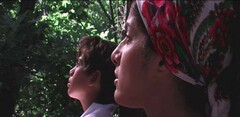The Electronic Intifada 19 May 2006
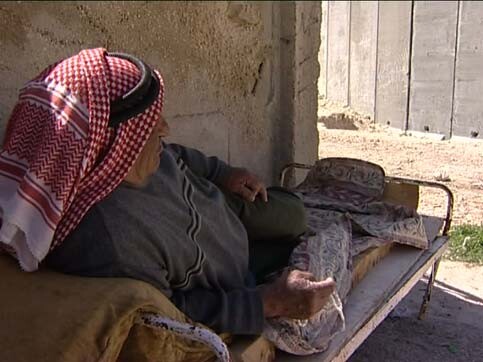
An Abu Dis resident in Issa Freij and Nicholas Wadimoff’s film Last Supper.
“Where is the world? Where is the world?”-Abu Dis Resident
Issa Freij and Nicolas Wadimoff’s documentary Last Supper (Abu Dis) examines a Palestinian village on the outskirts of Jerusalem that is slowly being enclosed by the Israeli apartheid wall. The twenty-six minute film exposes the violations of human rights that are resulting from the supposed “security” measurements the Israeli government has taken over the past six years.
 As the wall expands, Palestinians continue to be cut off from their communities, land, farms, families and social infrastructures. Freij and Wadimoff interview Abu Dis residents, as the construction of the wall takes place literally in their front and back yards.
As the wall expands, Palestinians continue to be cut off from their communities, land, farms, families and social infrastructures. Freij and Wadimoff interview Abu Dis residents, as the construction of the wall takes place literally in their front and back yards.
As several narratives are intertwined with striking shots of Palestinian landscape interrupted by the concrete monstrosity, the viewer begins to understand the extent and depth of the psychological and physical detriments that are resulting from the imprisonment of the entire community.
Through individual commentaries given by Abu Dis residents, the viewer learns that a denial of every aspect of Palestinian life is taking place as the suffocation and further ghettoization of Palestinians results from the building of the wall. Although the Israeli Ministry of Defense states that, “The matrix of civilian bonds and ties- economic, educational, medical etc, between Palestinian villages and cities has been thoroughly examined as well as the way they were affected by the construction of the Security Fence,” the interviews shown in Last Supper prove otherwise, as villagers discuss being cut off from their neighbors, schools, hospitals and employment opportunities.
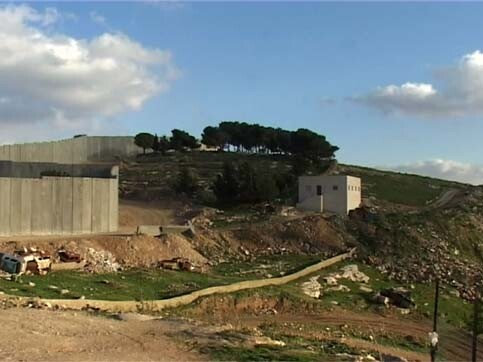
An image of the wall in Abu Dis in Last Supper, screened at the Chicago Palestine Film Festival.
In addition, the viewer learns that with the introduction of illegal Israeli settlements comes the governmental excuse that by law, Israel can control Palestinian land if it feels its citizens residing in the settlements are in a state of emergency. This allows the IDF to move about freely and “legally” in Abu Dis, though with its vast weaponry and history of aggression, such legal justification is superfluous.
While the film follows the constructing of the wall in front of one Abu Dis home, the viewer is shown the complexity of the situation, as one of the home owners begins the film by trying to find ways to resolve the trauma she is experiencing by transcending it and accepting her family’s fate of practically being cut off from the outside world. However, the deeper the viewer is taken into the narrative, the more one realizes that to live in such conditions and to somehow mentally transcend them would be impossible for any human being.
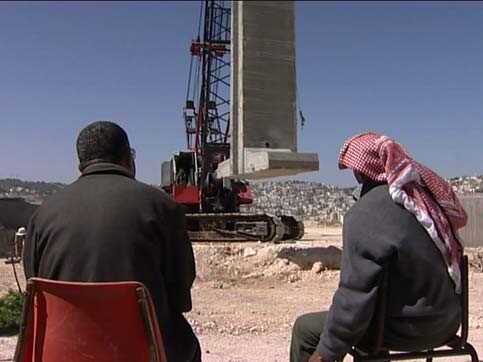
Two Abu Dis residents face the construction of the apartheid wall.
The individual narratives of the Abu Dis residents can be an area of strength for the film. Though, the specific shots that frame these interviews are inconsistent with the stunning scenes of Palestinian landscape contrasted against the stark imprisoning wall. Little attention is given to cinematic capacities during interviews, as subjects are simply shown speaking. Shots of the residents within the confined landscape, such as two men sitting with their backs to the camera as a concrete slab of the wall is laid, could carry the entire cinematic journey, especially the narration of the film. Moments of silence better capture the surreal and maddening environment the Israeli government has created.
The opening sequence specifically encapsulates the filmmakers’ patience with capturing a scene that demands the close examination and time and space needed to impact the viewer. A methodical sweep from a village home through the beginning slab of the encroaching wall, out to what little view of Jerusalem is left in the distance, provides the viewer with a clear demonstration of just how imposing and fatalistic the structure is. From this opening sequence, one can already imagine the sense of suffocation the residents describe later on in the film.
Additionally, the soundtrack of the film does not carry the weight of the issue at hand. A more complicated score, one whose sound does not detract from the situation’s severity, would better compliment the film.
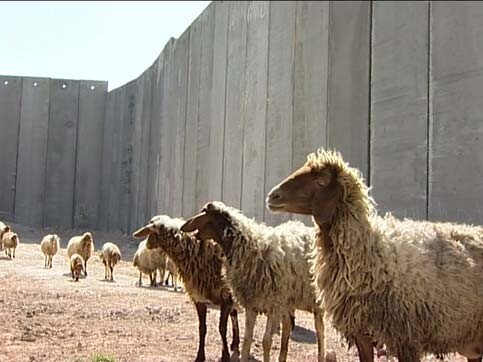
Sheep by the apartheid wall in Abu Dis, in Last Supper.
Ironically as Last Supper shows in this year’s Chicago Palestine Film Festival, we find that the United States is adopting similar tactics of the IDF with the current administration announcing plans to send 6,000 Guard troops to the Mexican border. This comes after months of some communities in the South West having relied on “Minute Men,” armed civilians who patrolled the border to prevent “illegal” border crossings. Such events parallel the operations of the IDF along with illegal settlers, who have been known to use armed force in their interactions with nearby Palestinians.

Abu Dis residents in Last Supper, by Issa Freij and Nicholas Wadimoff.
Last Supper is a call to action, as more Palestinian families are experiencing similar fates of Abu Dis residents in the name of Israeli “security.” With the most powerful country in the world supporting the wall and some of its major corporations benefiting financially from its construction (such as the Caterpillar corporation, whose equipment is shown in the film); is it only a matter of time before Americans see documentaries being made on their own apartheid wall?
Maymanah Farhat is a freelance writer and researcher of visual arts and culture, and is a specialist in Modern and Contemporary Arab art. EI has sponsored the Chicago Palestine Film Festival since its inception.
Related Links:




